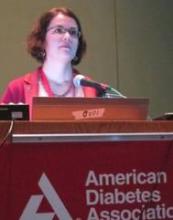CHICAGO – Hospital admissions for hypoglycemia exceed those for hyperglycemia among Medicare beneficiaries, with significant disparities existing between subgroups.
Blacks had a fourfold higher admission rate for hyperglycemia and hypoglycemia than did whites during 1999-2011, while those aged 85 years and older had twofold higher admissions for hypoglycemia than did younger beneficiaries.
"Continued efforts are needed to reduce hypoglycemia, particularly among blacks and oldest patients," Dr. Kasia J. Lipska said at the annual scientific sessions of the American Diabetes Association. "We suggest that assessment of adverse effects of treatment, such as hypoglycemia, is important to fully understand the impact of treatment strategies."
More intensive glycemic control and increased availability of glucose-lowering drugs in the past 2 decades has helped drive down hospitalizations for hyperglycemia, but as an unintended consequence, admissions for hypoglycemia may have risen, particularly in older patients.
The investigators evaluated changes in admission rates for principal discharge diagnoses of hyperglycemia or hypoglycemia among nearly 34 million Medicare fee-for-service patients, aged 65 and older, from 1999 to 2011. Hyperglycemia diagnoses included uncontrolled diabetes, diabetic ketoacidosis, diabetes with hyperosmolarity, and diabetes with other coma. Hypoglycemia diagnoses were hypoglycemic coma; diabetic hypoglycemia not otherwise specified or hypoglycemic shock; specified and unspecified hypoglycemia; and poisoning by insulin or antidiabetic agents.
During the study period, 302,095 patients were hospitalized for hyperglycemia and 429,850 for hypoglycemia, reported Dr. Lipska, instructor in medicine (endocrinology) at Yale University, New Haven, Conn.
Hyperglycemia admissions fell 39% from 114/100,000 patient-years in 1999 to 70/100,000 patient-years in 2011.
On the other hand, hypoglycemia admissions increased steadily from 94/100,000 patient-years in 1999 to their peak of 130/100,000 in 2007, declining modestly since then to 105/100,000 in 2011.
"There has been a flip, with hypoglycemia now clearly exceeding hyperglycemia by 2011," Dr. Lipska said.
After adjustment for diabetes prevalence, hyperglycemia admissions came down even more dramatically, falling by 55% from 1999 to 2011 (820 to 367/100,000 patient-years), while hypoglycemia admissions appear more stable, with a slight decline overall (676 to 612/100,000 patient-years), she added.
Session comoderator Dr. Hermes Florez, with the University of Miami Health System, said in an interview, "Clearly, with the change in practice and a growing of the elderly population, we’re doing a better job reducing significantly the hyperglycemic events, but maybe being too aggressive at some point, especially with the elderly population, may have triggered a higher incidence of hypoglycemia."
He observed that admission trends began to shift in 2007, possibly reflecting the reduction in rosiglitazone (Avandia) use, after the drug was found to increase the risk of heart attacks. At the same time, enthusiasm for intensive glycemic control began to wane as a result of the excess mortality reported in the pivotal ACCORD (Action to Control Cardiovascular Risk in Diabetes) trial (N. Engl. J. Med. 2008;358;2545-59).
"The tasks for us are to reduce, hopefully, the rates of hypoglycemia by better educating providers, and tailoring this education to the different subgroups of older adults," Dr. Florez said. "You might have individuals that are quite functional, and you can be more aggressive in these patients, but you also have more vulnerable individuals who are more prone to hypoglycemia."
During a discussion of the analysis, an audience member asked whether paramedic data were included as the results could represent a great underestimate because many patients receive treatment for diabetic-related emergencies outside the hospital setting.
Dr. Lipska said these data were not available, but agreed that this may be only the tip of the iceberg. "Yes, there are lots of patients who are seen by paramedics and never see a doctor in the emergency room," she remarked.
The study was supported by the National Heart, Lung, and Blood Institute and the National Institute on Aging. Dr. Lipska reported having no financial disclosures.


